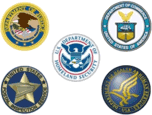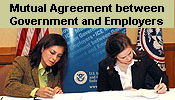|
June 27, 2008
National
Intellectual Property Rights
Coordination Center

Response to Growing Threat
In recent years, the threat to intellectual property rights (IPR) has grown in magnitude and complexity. Industry and trade associations estimate that counterfeiting and piracy cost the U.S. economy in excess of $200 billion per year and more than 750,000 American jobs. However, as great as the monetary loss is, the loss of technological superiority and trade competitiveness to U.S. trademark and copyright owners is immeasurable.
The business community is not the only victim. Counterfeit, substandard or tainted products that are disguised as trusted brands pose a major threat to public health and safety. Substandard, tainted goods such as food products (both human and pet consumables), pharmaceuticals (both lifestyle and life-saving drugs), aircraft or automobile parts, toys and baby furniture, and building and manufacturing components have been the subject of seizures and public recalls.
The impetus behind this burgeoning threat has always been the tremendous profits realized in the sale of counterfeit goods. Criminal organizations take advantage of established smuggling infrastructures and routes to move everything from toothpaste and handbags to surgical supplies and life-saving medicines.
Partnership in Action
The National Intellectual Property Rights Coordination Center (IPR Center) has been the federal government’s central point of contact in the fight against IPR violators and the flow of counterfeit goods into the commerce of the United States since 2000. The new center in Northern Virginia is the high-tech home of a partnership between government, private industry and law enforcement communities.
The Department of Homeland Security’s U.S. Immigration and Customs Enforcement and Customs and Border Protection, Health and Human Services’ Food and Drug Administration, the Department of Justice’s FBI, the Department of Commerce and U.S. Postal Inspection Service are partners to:
- More effectively use member agencies’ authorities and resources to combat the global threats to public safety and national security posed by the importation into the U.S. of counterfeit, substandard and tainted products.
- Jointly manage investigative leads and coordinate investigations and operations nationally and internationally for maximum impact.
- Enhance working relationships with existing and emerging industries to identify the threats to intellectual property and trademarks.
- Provide comprehensive training to domestic and international law enforcement agencies on investigative best practices to broaden IPR protection and expand transnational enforcement capabilities.
The IPR Center serves as a fusion point for intelligence on IPR violations from other government agencies, industry, transportation providers and others. The IPR Center partners employ a three-pronged strategy in the fight against intellectual property crime:
Investigation
The investigative prong of the IPR Center strategy focuses not only on keeping counterfeit products out of the United States, but also on identifying and dismantling the criminal organizations behind this activity.
IPR Center partners act on this intelligence to track down sources of counterfeit goods, identify smuggling and trade routes, and seize the merchandise at critical points before it enters the U.S. marketplace.
Interdiction
A critical step in fighting intellectual property rights violations is interdicting the flow of counterfeit goods-stopping the flow of goods into U.S. commercial markets and onto U.S. streets. The globalization of trade has made protecting our domestic marketplace an increasingly complex challenge.
Training and Outreach
The third prong of the IPR Center strategy focuses on prevention of intellectual property crime by providing outreach and training to the public and our private and law enforcement partners.
For industry stakeholders, both domestic and international, the IPR Center serves as a clearinghouse for information on trends in counterfeiting and smuggling, sharing information and receiving tips and information on new methods that criminal organizations are employing. In addition, the IPR Center provides training for domestic and international law enforcement agencies on investigative best practices, with the goal of building awareness of IPR violations and expanding enforcement capabilities.
For more information contact:
The National Intellectual Property Rights Coordination Center
2451 Crystal Drive, Suite 200
Arlington, VA 22202
Web site: www.ice.gov
E-mail: IPRCenter@dhs.gov
Phone: 866-IPR-2060
| 
![]()







